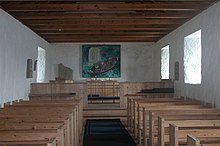Saint Olav Church (Kirkjubøur)



The Saint Olavs Church ( fär. Ólavskirkjan "Olavskirche") in Kirkjubøur was built around 1250 and is the oldest preserved church building in the Faroe Islands . The famous church stalls at Kirkjubøur once formed their inventory.
It is located on the west coast in the very south of the island of Streymoy directly on the coast and is the main attraction of the place next to the unfinished ruins of the Magnus Cathedral and the still-inhabited Viking court from the 11th century . These three buildings are in close proximity to each other and are on the list of candidates for UNESCO World Heritage Sites .
Olav's Church is 21.8 meters long and 7.5 meters wide. It is made of rough stones and plastered white on both sides. It only received the church tower in 1855.
Olav's Church is named after the Norwegian King Olav the Holy (995-1035), who is still venerated in the Faroe Islands today, but never entered it ( see Ólavsøka , National Day of the Faroe Islands). But it was probably originally dedicated to the Virgin Mary .
The Olavskirche was the center of the diocese of Faroe Islands . The most famous bishop was Erlendur , who had the Magnus Cathedral built next to the church around 1300 . However, this building was never completed, so that the Church of Olav served as the seat of the Faroe Islands' bishops until the Reformation in the Faroe Islands (1538) . Today it is the parish church of Kirkjubøur, which literally means "church village" and refers to the meaning of the church.
1963-66 extensive archaeological investigations took place under the church and showed that soon after the Christianization of the Faroe Islands a church must have stood here. A total of three floors from the Middle Ages were discovered. Five coins were found under the oldest floor, the oldest of which comes from England and must have been minted between 1223 and 1235.
Two episcopal graves were also discovered in the choir. Carbon research showed that the tomb dates from the mid-13th century. It is therefore assumed that today's church was built around that time. A wooden bishop's staff with a gilded head was found in the tomb and is now on display in the Faroe Islands History Museum . A copy of the bishop's staff is in a showcase in Olav's Church . The two gravestones found are now placed in the choir.
In 1875 the church was fundamentally rebuilt and rededicated by Provost VU Hammershaimb on December 15th. It was also Hammershaimb who recognized the value of the old stalls in Olav's Church and had them moved to the Danish National Museum. It was not until 2002 that the valuable cheeks came back to the Faroe Islands and are now on display in the National Museum.
Also in the National Museum is an excellently preserved carved Madonna with Baby Jesus from the late 11th century, which stood in the Olavskirche until the renovation in 1875, but, unlike the pews, has never left the islands. Presumably it is of Anglo-Saxon origin. In 1959, restoration work began on the statue. The white lime layer was removed and the original paintwork appeared. It turned out to be one of the most beautiful medieval wooden sculptures in the north.
Another gem from the Ólavskirche is the figure of Christ from the period between 1450 and 1500. However, it is in a much worse condition with no arms and a face that has become unrecognizable.
There is a small hole in the north wall of the church through which lepers had to attend the services from outside until the 1740s . That way they could partake of the sacrament.
Another major renovation took place in 1965–67, and it was rededicated on September 3, 1967. The altarpiece was created by the painter Sámal Mikines . It represents a fishing boat. Tróndur Patursson designed the glass art at the entrance gate .
In contrast to most other churches in the Faroe Islands, Olav's Church is never closed, so it can be visited at any time.
literature
- Jákup Pauli Gregoriussen : Eldru hválvkirkjurnar. Forlagið í Støplum, Velbastað 1997, ISBN 99918-914-1-2 (on the older vaulted churches; English summary The Old Vaulted Churches, pp. 306–308) (This article is based on the extract from Folkakirkjan.fo ).
- James Proctor: Faroe Islands. The Bradt Travel Guides, Chalfont St. Peter 2004, ISBN 1-84162-107-2 (English travel guide. S 78 f. "Ólavskirkjan church").
- Steen Ulrik Johannessen: Doors går til Færøerne. Politics Forlag, Copenhagen 2005, ISBN 87-567-7087-1 (Danish travel guide. P. 39 “Sognekirken”).
- Anchor Eli Petersen : Maria & Kristus. In: News from the Faroe Islands. 2/2007, Postverk Føroya , Tórshavn (on the issue of the Christmas stamps with the figure of Christ and the Madonna of Kirkjubøur on October 1st, 2007).
Web links
Individual evidence
Coordinates: 61 ° 57 ′ N , 6 ° 48 ′ W